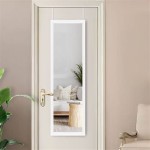Enhancing Gardens with Mirror Tiles: Aesthetics, Practicality, and Installation
Garden mirror tiles offer a unique and versatile method for enhancing outdoor spaces, providing aesthetic benefits, practical advantages, and opportunities for creative garden design. The strategic placement of these tiles can transform a small garden into a visually expansive environment or add subtle reflections that highlight specific features. Understanding the various types of mirror tiles available, their installation requirements, and their impact on the garden's ecosystem is crucial for successful implementation.
Types of Garden Mirror Tiles and Their Characteristics
The market offers a variety of mirror tiles suitable for garden use, each possessing different characteristics in terms of material, size, shape, and durability. Selecting the appropriate type is critical for achieving the desired aesthetic effect and ensuring long-term performance. Glass mirror tiles are the most common and offer a high-quality reflection. However, they are also the most fragile and susceptible to breakage from impact or extreme temperature fluctuations. Acrylic mirror tiles, often referred to as Plexiglas, are a lightweight and shatter-resistant alternative to glass. While they offer greater durability, acrylic mirrors can scratch more easily and may not provide the same level of clarity as glass.
Stainless steel mirror tiles represent a robust option for gardens, particularly in areas prone to vandalism or severe weather. These tiles are highly resistant to impact and corrosion, making them ideal for ground-level installations or areas with high foot traffic. However, stainless steel mirrors can be more expensive than glass or acrylic and may have a slightly distorted reflection. Flexible mirror sheets are another alternative, particularly for curved surfaces or unique garden features. These sheets can be cut to size and adhered to various materials but their reflective quality is generally lower than that of rigid tiles.
The size and shape of garden mirror tiles also play a significant role in their visual impact. Small, mosaic-style tiles can be used to create intricate patterns and add subtle reflections, while larger tiles can create the illusion of depth and space. Square and rectangular tiles are the most common, providing a clean and modern aesthetic. However, circular, hexagonal, and other geometric shapes can be used to create more dynamic and visually interesting designs. The choice of shape and size should align with the overall garden design and the desired level of reflectivity.
Practical Benefits and Considerations for Using Mirror Tiles in Gardens
Beyond their aesthetic appeal, garden mirror tiles offer several practical benefits. One of the most significant advantages is their ability to enhance natural light, particularly in shaded areas of the garden. By reflecting sunlight, mirror tiles can brighten dark corners and create a more inviting atmosphere. This increased light can also benefit plants, promoting growth and flowering in areas that would otherwise receive insufficient sunlight. However, it is important to consider the potential for concentrated sunlight to scorch delicate plants, so careful placement is essential.
Garden mirror tiles can also be used to deter pests, particularly birds. The sudden reflection of light can startle birds and prevent them from damaging plants or feeding on fruits. However, it is crucial to ensure that the mirrors do not create a hazard for birds by reflecting the sky in a way that mimics open space, potentially leading them to fly into the mirrors. The strategic placement of mirrors near bird feeders or areas where birds frequently congregate can be particularly effective. Some gardener employ motion activated sprinklers in conjunction with reflective surfaces.
Maintenance is another critical consideration when using mirror tiles in the garden. Like any outdoor surface, mirror tiles will accumulate dirt, dust, and debris over time, which can diminish their reflective quality. Regular cleaning with a mild detergent and water is necessary to maintain their appearance. Additionally, the tiles should be inspected periodically for cracks, chips, or other damage, which can compromise their structural integrity and safety. The type of cleaning product used should be carefully selected to avoid damaging the mirror surface. Abrasive cleaners or harsh chemicals can scratch or dull the finish.
Environmental factors, such as humidity and temperature fluctuations, can also affect the longevity of garden mirror tiles. In areas with high humidity, condensation can accumulate on the mirror surface, leading to water spots or corrosion. Choosing tiles made from weather-resistant materials is crucial in such climates. Similarly, extreme temperature fluctuations can cause expansion and contraction, which can lead to cracks or detachment. Proper installation with appropriate adhesives and expansion joints can help mitigate these effects.
Installation Techniques and Placement Strategies for Optimal Effect
Proper installation is essential for ensuring the longevity and effectiveness of garden mirror tiles. The installation process will vary depending on the type of tile, the surface to which it is being attached, and the desired aesthetic effect. Before installing any tiles, it is crucial to prepare the surface by cleaning it thoroughly and ensuring it is level and stable. Uneven surfaces can cause the tiles to crack or detach over time. For wooden surfaces, a primer may be necessary to improve adhesion. For masonry surfaces, a sealant may be required to prevent moisture from seeping behind the tiles.
Adhesive selection is also critical. The adhesive should be specifically designed for outdoor use and capable of withstanding the elements. Construction adhesive is a common choice for securing mirror tiles to various surfaces. However, it is essential to follow the manufacturer's instructions carefully and ensure that the adhesive is compatible with both the tile and the substrate. For larger tiles, mechanical fasteners, such as screws or nails, may be necessary to provide additional support.
Placement strategies play a crucial role in achieving the desired visual effect. Mirrors can be used to create the illusion of depth and space by placing them at the end of a narrow pathway or behind a dense planting. This can make a small garden feel larger and more inviting. Mirrors can also be used to reflect specific features, such as a fountain, a sculpture, or a particularly beautiful plant. By strategically positioning the mirrors, these features can be highlighted and enjoyed from multiple angles.
Careful consideration should be given to the angle of the mirrors to avoid reflecting undesirable elements, such as fences, sheds, or neighboring buildings. Angling the mirrors slightly downward can help to reflect the ground and plants, creating a more natural and harmonious effect. It is also important to avoid placing mirrors in direct sunlight, as this can create glare and discomfort. Ideally, the mirrors should be positioned to reflect indirect sunlight or shaded areas. Safety is paramount during installation. Wearing safety glasses and gloves is essential to protect against cuts and injuries. When cutting tiles, use appropriate tools and techniques to avoid shattering or splintering. If using power tools, follow all safety precautions and wear appropriate protective gear. Securing the tiles firmly is crucial to prevent them from falling and causing injury. Regular inspections should be conducted to identify and address any potential hazards.
In conclusion, garden mirror tiles represent a versatile and effective method for enhancing outdoor spaces. Understanding the different types of tiles available, their practical benefits, and their installation requirements is crucial for successful implementation. By carefully selecting and strategically placing mirror tiles, gardeners can create visually stunning and inviting outdoor environments.

Six Ideas For Styling Mirrors In Your Garden Bbc Gardeners World

Snowdrop Stained Glass And Mirror Mosaic Made With Materials For Interior Or Exterior Use Perfect A Garden Corner To Reflect Light

Buy Primrose Acrylic Non Shatter Outdoor Wall Mounted Hexagonal Silver Garden Illusion Mirror 40cm At B Q

Lovely Mirror Copper Slate Stone Tiles Grey Silver Handmade Wall Decor Art Unique Statement Mosaic

Diy Projects Involving Tiles

Mosaic Mirror For The Garden Or Home

12 Garden Mirror Ideas Create An Illusion Of Bigger

Mosaic Garden Mirror With Broken Mexican Tiles

Create Your Own Mosaic Round Mirror

Six Ideas For Styling Mirrors In Your Garden Bbc Gardeners World







